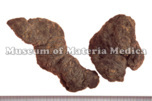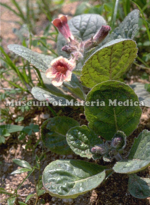Rehmannia Root

|
Market name:地黄 Photo location:Museum of Materia Medica, Inst. of Nat. Med. TMPW No.:13598 |

|
Plant name:Rehmannia glutinosa Photo location:Nara Pref., Japan Photo date:1997 Photographer:K. Komatsu |
| Synonym | Chinese Foxglove Root |
| Latin name | Rehmanniae Radix |
| Botanical source: Family name | Scrophulariaceae |
| Botanical source: Plant name | - Rehmannia glutinosa var. purpurea Makino - Rehmannia glutinosa Steudel (IPNI:808644-1) |
| Part used | Tuberous root |
| Empirical criteria for quality selection | The periderm of the root is grey and the inside is deep violet in color. The taste is sweet with a faint bitterness. More mature and bigger ones are better. (NI) |
| Constituents | Lipids: Cerebroside, Jio-cerebroside Sugar: Manninotriose, Verbascose Monosaccharides: D-Mannitol, D-Glucose, D-Fructose, D-Galactose Oligosaccharides: Raffinose, Stachyose, Sucrose Monoterpenoids: Iridoids: Catalpol, Aucubin, Rehmannioside A, Rehmannioside B, Rehmannioside C, Rehmannioside D, Rehmaionoside A, Rehmaionoside B, Rehmaionoside C, Rehmaionoside D, Melittoside, Leonuride Carotenoids & Vitamin A: Vitamin A Sterols: Sitosterol Phenol derivatives: Acteoside Amino acids: Arginine Other: Fe |
| Pharmacological effects | Hypoglycemic, cardiotonic, hypertensive, diuretic (extract). Cathartic and diuretic (catalpol). |
| Indications | As a tonifying and heat-clearing drug, for reducing heat in blood, nourishing blood, it is applied to treat hematemesis, thirst and mental instability. |
| Diseases | Fever, Thirst, Constipation, Sore throat, Hematemesis, Nasal hemorrhage, Hematuria, Hematochezia, Irregular vaginal bleeding, Bleeding, Internal bleeding, Polyposia |
| Formulas | ishoho , unseiin , ogibekkoto , odoto , kagenryokakusan (kyoteiken) , kakkonkokato , kamiuntanto , kamishimotsuto , kamishoyosankasenkyujio , kanroin , kyukikyogaito , kyukichoketsuin , kyukichoketsuindaiichikagen , keigairengyoto , kogikujiogan , goshajinkigan , gorinsan , saikoseikanto , sammotsuogonto , shichimotsukokato , shimotsuto , shakanzoto , shofusan , shinsentaitsuko , jiinkokato , jiketsujunchoto , jijintsujito , jijinmeimokuto , juzentaihoto , junchoto , seinetsuhoketsuto , senkanmeimokuto , sokeikakketsuto , daibofuto , chibakujiogan , choreitogoshimotsuto , tokiinshi , dokkatsukakkonto , ninjin'yoeito , hachimijiogan , mibakujiogan , ryutanshakanto , renjuin , rokumigan |
| Meridian tropism | Heart, Liver, Kidney |
| Property | Cold |
| Flavor | Sweet, Bitter |
| Classification in "Shen-non Ben-cao Jing" | Superior |
| TCM: Classification | Drugs for noulishing blood |
| TCM: Medicinal effects | To reduce heat in blood, to nourish yin and promote the production of body fluid. Used for febrile diseases with deep red tongue and thirst, deficiency of yin and internal heat, consumptive fever, diabetes caused by internal heat, hematemesis, epistaxis, skin eruption and maculation. |
| Remarks | Listed in the Japanese Pharmacopoeia 18th ed. |
| References | NI: N. Isshiki, Methods of Quality Evaluation and Preparation of Wakan-yaku [Wakanyaku no ryohi kanbetsu-ho oyobi chosei-ho], Tohodo Shoten, Tokyo, 1987. |
DNA sequences of medicinal plants
